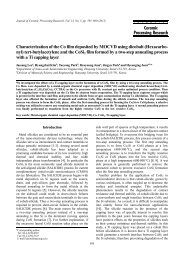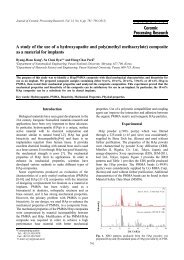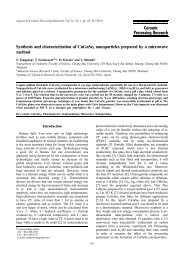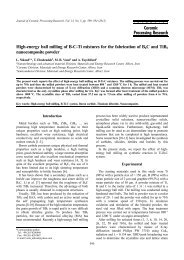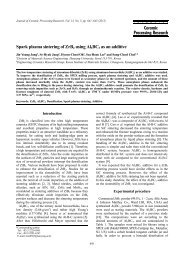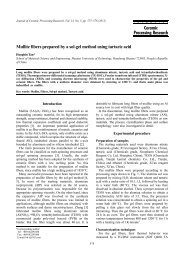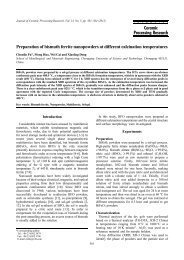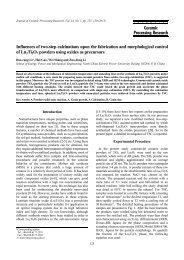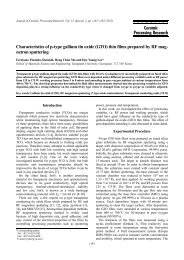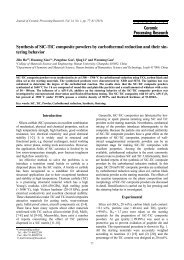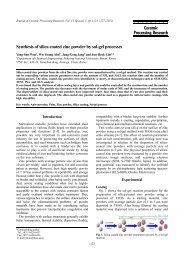Preparation and sintering behavior of Al2O3-Y2O3/ZrB2 composite ...
Preparation and sintering behavior of Al2O3-Y2O3/ZrB2 composite ...
Preparation and sintering behavior of Al2O3-Y2O3/ZrB2 composite ...
You also want an ePaper? Increase the reach of your titles
YUMPU automatically turns print PDFs into web optimized ePapers that Google loves.
<strong>Preparation</strong> <strong>and</strong> <strong>sintering</strong> <strong>behavior</strong> <strong>of</strong> Al 2 O 3 -Y 2 O 3 /ZrB 2 <strong>composite</strong> powders 605<br />
ceramics with Al 2 O 3 -Y 2 O 3 <strong>composite</strong> powder added is<br />
higer than that <strong>of</strong> ZrB 2 -YAG ceramics with YAG powder<br />
added, which indicates the A1 2 O 3 -Y 2 O 3 /ZrB 2 <strong>composite</strong><br />
powders are more easily prepared <strong>and</strong> have a higher<br />
density than ZrB 2 -YAG ceramics.<br />
Acknowledgments<br />
Fig. 7. SEM <strong>of</strong> ZrB 2 -20 wt%YAG ceramics (a-Coated ZrB 2 with<br />
Al 2 O 3 -Y 2 O 3 , b-Mixed ZrB 2 with YAG).<br />
that is, <strong>sintering</strong> from 700 o C to 1600 o C. YAG is produced<br />
from 700 o C to 950 o C. The reaction temperature is lower<br />
than the 1100 o C for synthesizing YAG powders from<br />
Al 2 O 3 -Y 2 O 3 <strong>composite</strong> powders, because ZrB 2 particles<br />
are changed electrically during the entire <strong>sintering</strong> process,<br />
which produces a plasma among ZrB 2 particles to purify<br />
the nearby particle surfaces <strong>and</strong> increase the <strong>sintering</strong><br />
activity [16-18].<br />
However, the Z-axis displacement for powders with<br />
YAG added shows a lower shrinkage displacement below<br />
950 o C; a larger shrinkage displacement is shown from<br />
950 o C to 1600 o C, the Z-axis displacement is not varied<br />
basically above 1700 o C. The Z-axis displacement adding<br />
the different powders both show the same shrinkage<br />
state from 950 o C to 1600 o C, YAG melts above 950 o C,<br />
the temperature is lowered because <strong>of</strong> the action <strong>of</strong> the<br />
plasma. Because the results <strong>of</strong> the two routes both show<br />
the Z-axis displacement is not varied basically above<br />
1700 o C, a <strong>sintering</strong> temperature <strong>of</strong> 1700 o C is choosen<br />
for preparing high density ZrB 2 -YAG multiphase ceramics,<br />
the microstructure <strong>of</strong> ZrB 2 -YAG multiphase ceramics<br />
are shown in Fig. 7, which indicates the density <strong>of</strong> ZrB 2 -<br />
YAG ceramics with Al 2 O 3 -Y 2 O 3 <strong>composite</strong> powder added<br />
is higer than that <strong>of</strong> ZrB 2 -YAG ceramics with YAG<br />
powder added.<br />
Conclusions<br />
Al 2 O 3 -Y 2 O 3 /ZrB 2 <strong>composite</strong> powders were prepared<br />
by a co-precipitation methods. When the pH is 9, the<br />
encapsulted structure <strong>of</strong> A1(OH) 3 -Y(OH) 3 /ZrB 2 <strong>composite</strong><br />
powders is the best. By analyzing the ZrB 2 surface status<br />
with SEM, EDS, TEM <strong>and</strong> XRD, the A1 2 O 3 -Y 2 O 3 /ZrB 2<br />
<strong>composite</strong> powders were prepared under the calcining<br />
conditions <strong>of</strong> 600 o C in argon. The density <strong>of</strong> ZrB 2 -YAG<br />
The authors are thankful for the financial support provide<br />
by the Science <strong>and</strong> Technology Support Fund for Young<br />
Scholars <strong>of</strong> the Educational Department <strong>of</strong> Jiangxi Province,<br />
China (Grant No.GJJ09595), <strong>and</strong> for the apparatus provided<br />
by The Center for Materials Testing <strong>and</strong> The Functionally<br />
Gradient Material (FGM) Research Laboratory <strong>of</strong> Wuhan<br />
University <strong>of</strong> Technology, China.<br />
References<br />
1. L. Silvestroni, D. Sciti, C. Mel<strong>and</strong>ri <strong>and</strong> S. Guicciardi, J.<br />
Eur. Ceram. Soc. 30 (2010) 2155-2164.<br />
2. S.M. Zhu, W.G. Fahrenholtz, G.E. Hilmas <strong>and</strong> S.C. Zhang,<br />
Mater. Sci. Eng. A 459 (2007) 167-17.<br />
3. J.G. Song, G.C. Ji <strong>and</strong> S.B. Li, J. Ceram. Process. Res. 10<br />
(2009) 428-432.<br />
4. P. Hu, X.H. Zhang <strong>and</strong> J.C. Han, J. Am. Ceram. Soc., 93<br />
(2010) 345-349.<br />
5. I.B. Bankovskaya, M.P. Semov <strong>and</strong> A.E. Lapshin, Glass<br />
Phys. Chem., 31 (2005) 433-438.<br />
6. A.L. Chamberlain, W.G. Fahrenholtz <strong>and</strong> G.E. Hilmas, J.<br />
Am. Ceram. Soc., 89 (2006) 450-456.<br />
7. J.G. Song, D.M. Du <strong>and</strong> Y.Y. Ju, J. Ceram. Process. Res.,<br />
11 (2010) 494-497.<br />
8. A. Bellosi, F. Monteverde <strong>and</strong> D. Sciti, Int. J. Appl. Ceram.<br />
Tec., 3 (2006) 32-40.<br />
9. H.F. Hu, Q.K. Wang <strong>and</strong> Z.H. Chen, Ceram. Int., 36<br />
(2010) 1011-1016.<br />
10. X.X. Li <strong>and</strong> W.J. Wang, Powder Technol., 196 (2009) 26-29.<br />
11. S.J. Wang, Y.B. Xua, P.X. Lua, C.F. Xu <strong>and</strong> W. Cao, Mater.<br />
Sci. Eng. B, 127 (2006) 203-206.<br />
12. Y.M. Zhang <strong>and</strong> H.M. Yu, Ceram. Int., 35 (2009) 2077-2081.<br />
[13] J. G. Song, Mater. Manuf. Process., 25 (2010) 724-729.<br />
14. R. Vallepu, A.M. Jimenez, T. Terai <strong>and</strong> A. Mikuni, J.<br />
Ceram. Soc. Jap., 114 (2006) 624-629.<br />
15. A.V. Radha <strong>and</strong> P.V. Kamath, Bull. Mater. Scie., 26 (2003)<br />
661-666.<br />
16. N. Frage, S. Kalabukhov <strong>and</strong> N. Sverdlov, J. Eur. Ceram.<br />
Soc., 30 (2010) 3331-3337.<br />
17. J.G. Song, D.M. Du <strong>and</strong> Y.Y. Ju, J. Reinf. Plast. Comp., 29<br />
(2010) 710-717.<br />
18. Y.H. Sang, H. Liu <strong>and</strong> Y.H. Lv, J. Alloy. Compd., 490<br />
(2010) 459-462.



